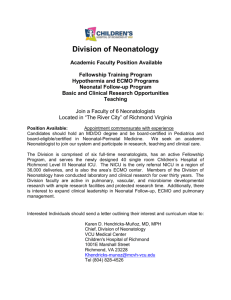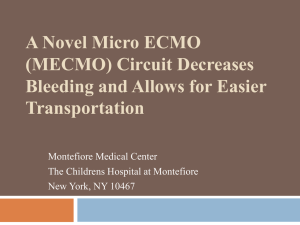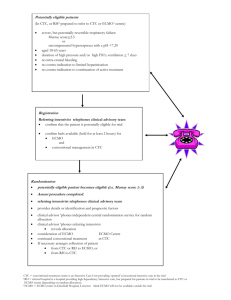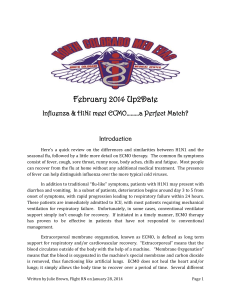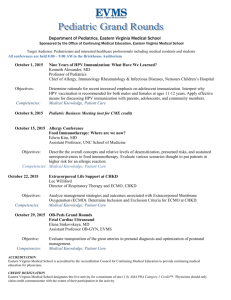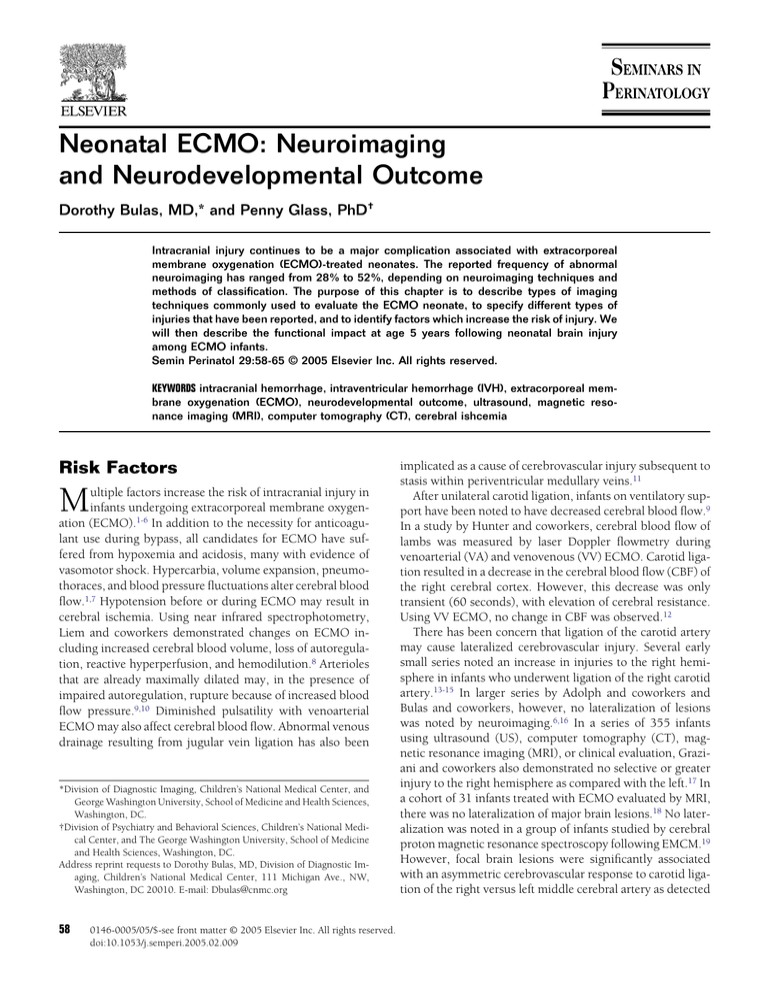
Neonatal ECMO: Neuroimaging
and Neurodevelopmental Outcome
Dorothy Bulas, MD,* and Penny Glass, PhD†
Intracranial injury continues to be a major complication associated with extracorporeal
membrane oxygenation (ECMO)-treated neonates. The reported frequency of abnormal
neuroimaging has ranged from 28% to 52%, depending on neuroimaging techniques and
methods of classification. The purpose of this chapter is to describe types of imaging
techniques commonly used to evaluate the ECMO neonate, to specify different types of
injuries that have been reported, and to identify factors which increase the risk of injury. We
will then describe the functional impact at age 5 years following neonatal brain injury
among ECMO infants.
Semin Perinatol 29:58-65 © 2005 Elsevier Inc. All rights reserved.
KEYWORDS intracranial hemorrhage, intraventricular hemorrhage (IVH), extracorporeal membrane oxygenation (ECMO), neurodevelopmental outcome, ultrasound, magnetic resonance imaging (MRI), computer tomography (CT), cerebral ishcemia
Risk Factors
M
ultiple factors increase the risk of intracranial injury in
infants undergoing extracorporeal membrane oxygenation (ECMO).1-6 In addition to the necessity for anticoagulant use during bypass, all candidates for ECMO have suffered from hypoxemia and acidosis, many with evidence of
vasomotor shock. Hypercarbia, volume expansion, pneumothoraces, and blood pressure fluctuations alter cerebral blood
flow.1,7 Hypotension before or during ECMO may result in
cerebral ischemia. Using near infrared spectrophotometry,
Liem and coworkers demonstrated changes on ECMO including increased cerebral blood volume, loss of autoregulation, reactive hyperperfusion, and hemodilution.8 Arterioles
that are already maximally dilated may, in the presence of
impaired autoregulation, rupture because of increased blood
flow pressure.9,10 Diminished pulsatility with venoarterial
ECMO may also affect cerebral blood flow. Abnormal venous
drainage resulting from jugular vein ligation has also been
*Division of Diagnostic Imaging, Children’s National Medical Center, and
George Washington University, School of Medicine and Health Sciences,
Washington, DC.
†Division of Psychiatry and Behavioral Sciences, Children’s National Medical Center, and The George Washington University, School of Medicine
and Health Sciences, Washington, DC.
Address reprint requests to Dorothy Bulas, MD, Division of Diagnostic Imaging, Children’s National Medical Center, 111 Michigan Ave., NW,
Washington, DC 20010. E-mail: Dbulas@cnmc.org
58
0146-0005/05/$-see front matter © 2005 Elsevier Inc. All rights reserved.
doi:10.1053/j.semperi.2005.02.009
implicated as a cause of cerebrovascular injury subsequent to
stasis within periventricular medullary veins.11
After unilateral carotid ligation, infants on ventilatory support have been noted to have decreased cerebral blood flow.9
In a study by Hunter and coworkers, cerebral blood flow of
lambs was measured by laser Doppler flowmetry during
venoarterial (VA) and venovenous (VV) ECMO. Carotid ligation resulted in a decrease in the cerebral blood flow (CBF) of
the right cerebral cortex. However, this decrease was only
transient (60 seconds), with elevation of cerebral resistance.
Using VV ECMO, no change in CBF was observed.12
There has been concern that ligation of the carotid artery
may cause lateralized cerebrovascular injury. Several early
small series noted an increase in injuries to the right hemisphere in infants who underwent ligation of the right carotid
artery.13-15 In larger series by Adolph and coworkers and
Bulas and coworkers, however, no lateralization of lesions
was noted by neuroimaging.6,16 In a series of 355 infants
using ultrasound (US), computer tomography (CT), magnetic resonance imaging (MRI), or clinical evaluation, Graziani and coworkers also demonstrated no selective or greater
injury to the right hemisphere as compared with the left.17 In
a cohort of 31 infants treated with ECMO evaluated by MRI,
there was no lateralization of major brain lesions.18 No lateralization was noted in a group of infants studied by cerebral
proton magnetic resonance spectroscopy following EMCM.19
However, focal brain lesions were significantly associated
with an asymmetric cerebrovascular response to carotid ligation of the right versus left middle cerebral artery as detected
Neonatal ECMO
59
dilation was an intracranial manifestation of generalized
edema.26 Other authors have suggested that increased sagittal
sinus pressure associated with internal jugular vein ligation
and cannulation of the superior vena cava is the cause of this
dilation due to decreased cerebrospinal fluid resorption of
the arachnoid villi.11,27 Widened extra axial space can develop as well, with severe cases noted following superior vena
cava thrombosis.28 VV ECMO is particularly prone to decreased venous drainage resulting in an increased incidence
of dilated interhemispheric fissure and prominent subarachnoid space.29 Due to the potential risk of venous stasis, cephalic drainage has been developed in an attempt to prevent
neurologic complications by maintaining normal cerebral
blood flow and increasing ECMO oxygen delivery.30
Cerebrovascular Imaging
Ultrasound
Figure 1 Axial CT image demonstrates mild prominence of the interhemispheric fissure and subarachnoid space.
by Magnetic Resonance Angiography (MRA) (P ⬍ 0.5).18
Schumacher and his colleagues5 have argued that no lateralization of lesions among ECMO-treated neonates is indicative
of increased vulnerability of the right hemisphere, since reports
of intraventricular hemorrhage (IVH) and stroke in nonECMO patients indicate relative vulnerability of the left
hemisphere.
It is believed that premature infants on ECMO are at high
risk of intracranial hemorrhage due to the presence of a friable germinal matrix with poor supporting stroma.1,2 Despite
the exclusion of small premature infants from ECMO, studies
have shown that younger infants continue to have a statistically significant increased risk of hemorrhage, even though
the mean age was 38 weeks and only 27% of the hemorrhages
originated in the germinal matrix.6 Although regions of ischemia are at risk for hemorrhage when heparin is used, infarcts
in term infants weighing over 3 kg typically do not progress
to hemorrhages.
Infants with sepsis are also at high risk for intracranial
hemorrhage likely due to additional problems with coagulopathy.20 In a series by Hardart and coworkers, gestational
age, sepsis, coagulopathy, and acidosis were all associated
with a higher incidence of intracranial hemorrhage21,22 Dela
Cruz and coworkers demonstrated that elevated ACT and
low platelet count were also associated with an increase in
intracranial hemorrhages.23
Infants with long circuit runs, particularly those with congenital diaphragmatic hernia, have the highest rate of major
nonhemorrhagic lesions. With more conservative use of heparin, the risk of partial venous occlusion and microemboli
has been shown to increase.6,24
Widened interhemispheric fissures have been well described in infants on ECMO, with rates of occurrence as high
as 59%3,25 (Fig. 1). Rubin and coworkers (1990) believed this
Ultrasound is particularly useful in the evaluation of infants
on ECMO due to its portability and lack of ionizing radiation.
The presence of a large intracranial hemorrhage is a contraindication for ECMO initiation, thus a screening examination
before cannulation is critical in the assessment of potential
therapeutic options. Ultrasound has been sensitive in the
evaluation of large cranial hemorrhages. In a series by Bulas
and coworkers, sonography successfully identified 46 (94%)
of 49 major intracranial hemorrhages, lesions that most affect
the way an infant is managed acutely.31 Identification of isolated subependymal hemorrhages has been shown not to be
at risk for progressive and should not prevent the initiation of
ECMO therapy.32
As the risk of hemorrhage is greatest in the first few days of
ECMO, daily cranial sonograms have been recommended for
the potential identification of a developing bleed. The question as to how often daily sonograms should be performed
Figure 2 Coronal US image demonstrates a large hemorrhagic infarct
of the right temporal lobe with herniation.
60
has been reviewed by several centers. In 1996, Biehl found
daily sonograms cost effective only during the first 3 days on
ECMO.33 In their series, 50% of intracranial hemorrhages
occurred in the first 24 hours, 75% by 48 hours, and 85%
within 72 hours of initiation of bypass. Further sonograms
were deemed unnecessary unless there was a change in neurological status or multi-organ failure. Khan and coworkers
suggested performing cranial sonograms for the first 5 days
on ECMO unless a clinical suspicion was raised.34
Large parenchymal hemorrhages are usually identified
sonographically as focal regions of increased echogenicity
(Fig. 2). With less than 30% of hemorrhages developing in
the germinal matrix, it is crucial to look carefully within the
peripheral parenchyma and posterior fossa for unusual regions of increased or decreased echogenicity. If a questionable lesion is identified, close follow up is useful as these
bleeds often increase rapidly in size. Hemorrhages may appear hypoechogenic due to decreased coagulation.
In a series of 117 infants with sonographic or CT evidence
of hemorrhage, 64% were parenchymal with 8.5% extraaxial.31 The most common site for a parenchymal bleed
was the cerebellum (27%). Cerebellar hemorrhages can be
difficult to identify by ultrasound via the anterior fontanelle.
A transmastoid view or imaging via the posterior fontanelle
may improve the sensitivity of identifying these hemorrhages
sonographically.35
Ultrasound is less successful in identifying nonhemorrhagic lesions. Generalized edema can be difficult to differentiate from normal, and Doppler tracings are not useful in
the assessment of autoregulation as pulsatility is diminished
on VA bypass. Despite these limitations, early screening has
been used to identify infants with severe edema. Von Allmen
and coworkers noted that infants with evidence of severe
edema on pre-ECMO sonograms had a 63% rate of occurrence of subsequent major intracranial complications36 (Fig.
3). Infarcts, small parenchymal hemorrhages, and extraaxial
collections may not be visible sonographically. Sonographic
distinction between hemorrhagic and ischemic lesions is difficult, as both can be echogenic. Numerous studies have
demonstrated the superiority of CT and/ or MRI in the identification of nonhemorrhagic and small hemorrhagic lesions.
CT contributed additional information in 73% of neonates
with intracranial abnormalities in a series of 286 infants
screened by US and CT.31 Seventeen of these were major
lesions not identified by ultrasound. Garber and coworkers
noted that of 6.8% ultrasounds reported to be normal, abnormalities were identified by CT.37
CT/MRI
Follow-up CT/MRI scans provide additional information in
72% to 93% of ECMO patients initially scanned with ultrasound.27,31,38,39 In a series of 130 infants with nonhemorrhagic abnormalities, the majority of abnormalities missed by
sonography were classified as minor. However, 6 infarcts, 3
diffuse periventricular hypodensities, and 5 moderate atrophies were demonstrated only by CT. Other series have also
D. Bulas and P. Glass
Figure 3 Axial CT image demonstrates diffuse hypoxic ischemic injury.
demonstrated that CT is particularly useful in identifying
infarcts, diffuse edema, and atrophy in infants with normalappearing sonograms.40
MRI can provide unique information at follow-up evaluation. MRA has demonstrated asymmetric cerebrovascular response to carotid ligation of the right versus left MCA.18
Cerebral proton magnetic resonance spectroscopy has been
used to assess potential changes in brain metabolism following ligation.19 It was hoped that single photon emission computed tomography (SPECT) could show deficits not seen by
neuroimaging.43 However, in a series by Kumar and coworkers, a normal SPECT scan was likely to predict normal outcome but an abnormal SPECT did not predict abnormal outcome.44 In a recent study using proton MRI and
spectroscopy, nine neonates were evaluated following
ECMO19 and no difference in right or left basal ganglia were
noted, suggesting that ligation of the carotid artery did not
produce persistent changes in brain metabolism in the basal
ganglia in this small group. Larger studies have not been
reported to date. As diffusion weighted imaging and higher
Tesla scanners become more available, further information
may become available for the assessment of ECMO-related
cerebrovascular injuries.
Clearly, the type of injuries incurred varies to a great extent. In an attempt to elucidate the functional significance of
the neuroimaging abnormalities, we developed and later
modified a scoring system of injury severity and used this as
a grouping variable (none, mild, moderate, severe) (Table
1).6 Using logistic regression, we demonstrated that the presence of neuroimaging abnormality by CT scan is the strongest
predictor of long-term outcome.41
Neonatal ECMO
Table 1 Representative Lesions by Severity on Routine Neonatal Neuroimaging
Mild (NIS ⴝ .05-3.5)
Wide interhemispheric fissure
Mild ventricular dilatation
Large subarachnoid space
Subependymal hemorrhage
Scattered petechial hemorrhages
Small extra-axial hemorrhages
Moderate (NIS ⴝ 4.0-6.0)
Single large parenchymal hemorrhage (>1 cm)
Patchy periventricular leukomalacia or hypodensity
Mild generalized atrophy
Combination of mild hemorrhagic and non-hemorrhagic
abnormalities
Severe (NIS >6.0)
Moderate to severe generalized atrophy
Diffuse periventricular leukomalacia
Multiple large parenchymal hemorrhages (>1 cm)
Large parenchymal infarct
Neurodevelopmental
Impact of Perinatal Brain Injury
Given the relatively high rate of neuroimaging abnormality
among ECMO-treated neonates, neurodevelopmental outcome studies have been important in defining the functional
impact. Substantial outcomes research in other populations
following perinatal brain injury underscores both neurospecificity and neuroplasticity in the young developing brain.
Earlier studies of neuroimaging and outcome in the preterm
infant serve as an important model for the ECMO-treated
neonate. The introduction of routine cranial ultrasounds for
preterm infants, rather than relying on CT scan for clinical
indications, identified an unexpectedly high rate of “silent”
hemorrhages; that is, injury not associated with handicap.
However, when neurodevelopmental outcome measures
were more specific than the designation of handicap versus
no-handicap and extended beyond the infant/toddler period,
more subtle neuropsychological deficits and learning problems were identified following perinatal brain injury. For
example, severity of periventricular brain injury in preterm
neonates is predictive of performance on a range of cognitive,
motor, and behavioral measures in preschool and school age
children.45-47
To address the question of relative impact of neonatal
brain injury, we conducted comprehensive neuropsychological and neurobehavioral assessment of 152 neonates treated
with ECMO and compared outcome at age 5 years according
to severity of brain injury on neonatal neuroimaging. The
outcome measures included intellectual status, preacademic
skills, neuropsychological deficits, and neuromotor dysfunction. Details of the study have been reported elsewhere.41
The ECMO study patients met institutional criteria for
ECMO and underwent VA bypass (the vessels were not reconstructed), had routine cranial ultrasounds daily during
bypass and a CT scan within 3 weeks of decannulation. The
neuroimaging findings were reviewed by a pediatric radiolo-
61
gist (DB) who was not aware of the neurodevelopmental outcome. Abnormalities were identified in 42% of the ECMO
cohort and scored for extent and severity. Four groups were
formed from the neonatal neuroimaging severity score: No
lesion (N ⫽ 88), Mild lesion (N ⫽ 38), Moderate lesion (N ⫽
12), and Severe lesion (N ⫽ 14) (See Table 1).
Fifty-three 5-year-old children who had not spent time in
a special care nursery, were given the same neurodevelopmental test battery and served as a normative group for data
analysis. They were comparable to the ECMO cohort in terms
of birth weight, gender, ethnicity, mother’s marital status,
and level of education achieved, home environment status,
and age at test. The control children did not have imaging
and were assumed to have normal brain structures.
The assessment protocol included a complete neuropsychological assessment, standard neurological evaluation, and
assessment of gross motor and fine motor function. The neuropsychological battery included administration of six
subtests of the Wechsler Preschool and Primary Scale of Intelligence-Revised (WPPSI-R short form) and additional
subtests to assess function in six neuropsychological domains: receptive and expressive language, verbal memory,
visual memory, visual-perceptual/spatial, visual-perceptual/
motor, and attention/executive function. In addition to the
standard neurological examination, four psychometric measures of left-side and right-side motor function included:
balance (duration on either foot), grip strength (hand dynamometer), dexterity (pegboard), and fine motor speed (finger
tapping). Mental disability was defined as mental retardation
(full scale IQ ⬍70) or severe learning disability (full scale
IQ ⬍70 but either verbal or performance IQ ⱖ80). Motor
disability was defined by presence of paresis or reflex and
tone abnormalities on the neurological examination, accompanied by motor function that was 2 or more years behind
age level (Gesell Developmental Schedule).
One or more major disability conditions occurred in 26 of
the 152 ECMO children (17%); 21 (14%) tested in the mentally retarded range or had severe learning disability; 8 children (5%) had a motor disability. One control child (2%)
tested in the range of mild mental retardation. None of the
normal control children had an abnormal neurological examination, but equal proportions of the ECMO and control
Figure 4 Severity of neonatal neuroimaging abnormality and rate of
disability at age 5 years (N ⫽ 152). Control children (N ⫽ 53) had
no neuroimaging, so normal brain structure is assumed.
D. Bulas and P. Glass
62
Table 2 Odds Ratios for Disability at Age 5 Years by Severity of Neonatal Neuroimaging, Relative to Normal Control Children
Severity of Abnormality
N
Abnormal
(%)
OR
95% CI
P
Normal Control
None
Mild
Moderate
Severe
53
88
38
12
14
1 (1.89)
9 (10.23)
5 (13.16)
4 (33.33)
8 (57.14)
5.924
7.879
26.00
69.33
0.73-48.16
0.88-70.46
2.57-263.06
7.351-653.91
0.090
0.078
0.003
<0.0001
children were found to have “suspect” neurological findings.
As predicted, major disability at age 5 years was a function of
neonatal neuroimaging abnormality (Fig. 4). We also computed the odds ratio and 95% confidence level for disability
at age 5 years for each neuroimaging subgroup compared
with the normal neuroimaging ECMO group (Table 2). The
risk for handicap following mild brain injury was only
slightly elevated compared with ECMO children who had
normal CT scans, but both of these groups are at greater risk
relative to the normal control children.
Severity of neonatal neuroimaging was significantly associated in a near-stepwise function with decreased intellectual
status, greater neuropsychological deficits, and poorer
preacademic skills (Fig. 5). Subtle effects of mild brain injury
are again evident. Figure 5 shows lower IQ scores for ECMO
children with mild brain injury relative to ECMO children
with no identified brain injury. In turn, both of these ECMO
subgroups are showing mild but consistent functional deficits relative to the normal control group (control group depicted as z scores ⫽ 0). Performance on psychometric measures of neuromotor function also showed a relative impact
by injury severity (Fig. 6), but only the grip strength (left
hand and right hand) and dexterity (left hand) reached statistical significance (P ⬍ 0.05).
Although prediction of neurodevelopmental deficit is of
clinical significance, this body of research also shows evidence of compensation following even moderate to severe
brain injury. Six of the 14 (43%) children in the severe neuroimaging group and 8 of 12 (67%) in the moderate brain
injury group were not disabled. The full scale IQ scores of
Figure 5 Brain injury severity on neonatal US/CT scan and neurocognitive outcome at age 5 years (N ⫽ 152). Z-scores computed
from normal control data (N ⫽ 53), thus control group mean ⫽ 0.
FSIQ ⫽ Full Scale IQ, VIQ ⫽ Verbal IQ, PIQ ⫽ Performance IQ.
FKSB ⫽ Florida Kindergarten Screening Battery (Adapted from
Glass and coworkers, 1997).
these 14 nondisabled children were all in the normal range or
above (84-127). Evidence of normal, or near normal, functioning after significant structural brain damage in the perinatal period has been generally attributed to the relative neuroplasticity of the immature brain, although symptoms may
be latent.
Right Hemisphere
Vulnerability of ECMO Neonate
Whether or not the neuroimaging data sufficiently support
increased structural vulnerability to the right hemisphere in
ECMO-treated neonates, some evidence of increased righthemisphere vulnerability is present at a functional level. The
preliminary question, however, is whether there is sufficient
neurospecificity in the neonate in regard to neuropsychological or motor functions.
Hemisphere Specialization in the Neonate
Unilateral brain injury that occurs in older children and
adults is followed by a predictable pattern of neuropsychological dysfunction; that is, language deficit after left hemisphere injury and visual pattern analysis deficit after right
hemisphere injury. The contralateral hand may or may not be
affected. When the unilateral brain injury occurs in the neonatal period, the pattern of deficit has not been as predictable
when using global measures, such as verbal IQ and performance IQ. However, selective deficits in receptive and expressive language, visual/motor integration, and behavior
problems have been identified in early childhood following
unilateral brain injury during the perinatal period.48-50 Nota-
Figure 6 Brain injury severity on neonatal US/CT scan and neuromotor function at age 5 years. Z-scores computed from normal
control data (N ⫽ 53), thus control group mean ⫽ 0. Dext. ⫽
dexterity (modified Purdue pegboard) Speed ⫽ rate of finger tapping.
Neonatal ECMO
bly, the effect of the side of lesion was consistent with the
predicted pattern in adult neuropsychological studies.
To address this issue, we identified 24 children in our
5-year-old ECMO cohort who had neuroradiographically
documented unilateral neonatal brain injury, and compared
the performance at age 5 years of those who had unilateral
neonatal left-sided lesions (N ⫽ 12) with those who had
unilateral neonatal right-sided lesions (N ⫽ 12) on selected
tasks reported to be predominantly mediated by the left
hemisphere (language comprehension and production and
right hand function) or by the right hemisphere (visual pattern discrimination and left hand function). Three specific
tests from the neuropsychological test battery were selected.
The Token Test is a measure of language comprehension
(Lang/Comp) which requires the child to carry out with disks
of different color, shape, or size a series of instructions that
increase in syntactic complexity. Poor performance is generally accepted as a marker of left hemisphere functional deficit.48 Rapid Automatized Naming (RAN) is a timed test that
requires the child to produce word labels (Lang/Prod) for a
repeated set of pictures of common objects. The RAN is also
sensitive to left-hemisphere deficit.51 Visual pattern discrimination52 requires the child match an abstract visual pattern
to one of four choices which increase in complexity (Visual/
Discrim). As a nonverbal measure of visual/spatial function it
is likely mediated by the right hemisphere.
We reported a significant association between the pattern
of neuropsychological deficit (language versus visual/spatial)
and the side of lesion, such that 75% of the Left-lesion group
were more likely to have a lower Language/comp score than
Visual/Discrim score; and conversely, 81% of the Right-lesion group were more likely to have lower Visual/Discrim
score relative to their Lang/Comp score.50 The pattern was
similar for language production, but not statistically significant. Excluding the one hemiparetic child, comparison of the
individual difference scores between the right and the left
hand for grip strength, rate of finger tapping, and dexterity
(pegboard) revealed no reliable association between side of
lesion and lateralized deficits. Therefore, on specific neuropsychological functions, but not psychomotor functions, the
hypothesis of hemisphere specialization in the neonate was
supported by the data.
Evidence of Right
Hemisphere Vulnerability at Age 5
Years Among ECMO-Treated Neonates
There is some evidence for right hemisphere functional
vulnerability among ECMO-treated neonates. We found
an increased rate of right-hand dominance (94%) among
our 5-year-old ECMO cohort, compared with our control
group and to the normal population (85%). (This is also in
contrast to an increased rate of left-hand dominance generally reported in high risk populations.) In addition, in
comparing the left hand and right hand performance on
psychometric measures, there is a suggestion of poorer
performance by the ECMO-left hand, relative to the con-
63
trol group (z ⫽ 0) versus the ECMO-right hand, relative to
control (z ⫽ 0). This is irrespective of the side of injury.
The larger question has been whether there is a particular neuropsychological profile of right-hemisphere vulnerability for the ECMO-treated neonate. The data demonstrate that the neuropsychological profile of the ECMO
cohort seems to vary according to brain injury severity,
rather than a dominance of functional deficits associated
with the right hemisphere (Fig. 5). For example, ECMO
children with no evidence of neonatal brain injury had a
neuropsychological profile parallel to the normal control
children. ECMO children with mild brain injury showed
relative vulnerability on verbally mediated tasks. ECMO
children with moderate-to-severe injury had a greater deficit in visual-perceptual and visual-motor tasks, relative to
verbally mediated tasks. This profile of language vulnerability following mild brain injury and greater deficits in
visual/spatial and visual/motor skills for children following
moderate/severe brain injury is also reported in other braininjured patient populations. Therefore, general findings of
visual/perceptual or performance IQ deficits among children treated with ECMO are apt to be associated with
moderate-severe brain injury, or perhaps a focal rightsided lesion, rather than a general right-hemisphere functional vulnerability.
Finally, as previously mentioned, there are frequent reports of widened interhemispheric fissure (IHF) found on
CT after ECMO decannulation, although the clinical significance has not been systematically studied.26 Lago and
coworkers reported significantly lower Bayley mental index and motor index at 6 and 12 months for a small group
of ECMO-treated neonates who had enlarged cerebrospinal fluid spaces, but the location of the enlargement was
not specified and may have included more generalized
enlargement.18 Eight of our ECMO cohort at age 5 years
had post decannulation CT scan evidence of widened interhemispheric fissure (in 7 of those patients it was the
only finding). The mean Full Scale IQ score was 84 for
these children, and all 8 of them had lower Verbal than
Performance IQ scores. The sample is too small to draw
firm conclusions, but the presence of widened IHF may
not be benign.
Summary
ECMO-treated neonates incur a relatively high frequency
of abnormalities identified on routine neuroimaging,
which vary widely in type and severity. Multiple risk factors are present before and during cannulation which primarily affect cerebral blood flow. Brain injury severity
identified in the neonatal period is predictive of neuropsychological status at age 5 years. Even those children with
apparently mild degrees of injury appear to have some
increased risk for neuropsychological deficits relative to
normal control children. Right-hemisphere vulnerability
is arguable at the structural level and only subtle in motor
function. Greater vulnerability of right-hemisphere brain
function is also reported in non-ECMO populations having
D. Bulas and P. Glass
64
moderate-severe brain injury. Finally, compounding the
effect of brain injury severity are other factors associated
with poorer neurodevelopmental status, including preECMO diagnosis other than meconium, lower birth
weight,53 presence of chronic lung disease after ECMO
therapy,42 and socioeconomic status.41
References
1. Cilley RE, Zwischenberger JB, Andrews AF, et al: Intracranial hemorrhage during extracorporeal membrane oxygenation in neonates. Pediatrics 78:699-704, 1986
2. Sell LL, Cullen ML, Whittlesey GC, et al: Hemorrhagic complications
during extracorporeal membrane oxygenation: prevention and treatment. J Pediatr Surg 21:1087-1091, 1986
3. Canady AI, Fessler RD, Klein MD: Ultrasound abnormalities in term
infants on extracorporeal membrane oxygenation. Pediatr Neurosurg
19:202-205, 1993
4. Luisiri A, Gravis ER, Weber T, et al: Neurosonographic changes in
newborns treated with extracorporeal membrane oxygenation. J Ultrasound Med 7:429-438, 1988
5. Schumacher RE, Palmer TW, Roloff DW, et al: Follow up of infants
treated with extracorporeal membrane oxygenation for newborn respiratory failure. Pediatrics 87:451-457, 1991
6. Bulas D, Glass P, O’Donnell RM, et al: Neonates treated with ECMO:
predictive value of early CT and US neuroimaging findings on shortterm neurodevelopmental outcome. Radiology 195:407-412, 1995
7. Volpe JJ: Neonatal intraventricular hemorrhage. N Engl J Med 304:886891, 1981
8. Liem KD, Hopman JC, Oesebeurg B, et al: Cerebral oxygenation and
hemodynamics during induction of ECMO as investigated by near
infrared spectrophotometry. Pediatrics 95:555-561, 1995
9. Short BL, Walker LK, Gleason CA, et al: Effects of extracorporeal membrane oxygenation on cerebral blood flow and oxygenation consumption in the newborn. Pediatr Res 21:425, 1988
10. Short BL, Walker LK, Bender KS, et al: Impairment of cerebral autoregulation during extracorporeal membrane oxygenation in newborn
lambs. Pediatr Res 33:289-294, 1993
11. Taylor GA, Walker LK: Intracranial venous system in newborns treated
with extracorporeal membrane oxygenation: Doppler US evaluation
after ligation of the right jugular vein. Radiology 183:453-456, 1992
12. Hunter CJ, Blood AB, Bishai JM, et al: Cerebral blood flow and oxygenation during venoarterial and venovenous ECMO in the newborn lamb.
Pediatr Crit Care Med 5:475-481, 2004
13. Hofkosh D, Thompson AE, Nozza RJ, et al: Ten years of extracorporeal
membrane oxygenation: neurodevelopmental outcome. Pediatrics 87:
549-555, 1991
14. Mendoza JC, Shearer LS, Cood LN: Lateralization of brain lesions following extracorporeal membrane oxygenation. Pediatrics 88:10041009, 1991
15. Hahn JS, Vaucher Y, Bejar R, et al: Electroencephalographic and neuroimaging findings in neonates undergoing extracorporeal membrane
oxygenation. Neuropediatrics 24:19-24, 1992
16. Adolph V, Ekelund C, Smith C, et al: Developmental outcome of neonates treated with extracorporeal membrane oxygenation. J Pediatr
Surg 25:43-46, 1990
17. Grazioani LJ, Gringlas M, Baumgart S: Cerebrovascular complications
and neurodevelopmental sequelae of neonatal ECMO. Clin Perinatol
24:655-675, 1997
18. Lago P, Rebsamen S, Clancy RR, et al: MRI, MRA, and neurodevelopmental outcome following neonatal ECMO. Pediatr Neurol 12:294304, 1995
19. van Rijn R, van der Crond J, de Vries LS, et al: Cerebral proton magnetic
resonance spectroscopy of neonates after ECMO. Acta Paediatr 90:
1288-1291, 2001
20. Zimmerman JJ, Deitrich KA: Current perspectives on septic shock.
Pediatr Clin North Am 43:131-138, 1987
21. Hardart GE, Hardart MK, Arnold JH: Intracranial hemorrhage in pre-
22.
23.
24.
25.
26.
27.
28.
29.
30.
31.
32.
33.
34.
35.
36.
37.
38.
39.
40.
41.
42.
43.
44.
45.
46.
mature neonates treated with ECMO correlates with conceptional age.
J Pediatr 145:184-189, 2004
Hardart GE, Fackler JC: Predictors of intracranial hemorrhage during
neonatal ECMO. J Pediatr 134:156-159, 1999
Dela Cruz TV, Stewart DL, Winston SJ, et al: Risk factors for intracranial
hemorrhage in the ECMO patient. J Perinatol 17:18-23, 1997
Fink SM, Bockman DE, Howell CG, et al: Bypass circuits as the source
of thromboemboli during extracorporeal membrane oxygenation. J Pediatr 115:621-624, 1989
Babcock DS, Han BK, Wiess RG, et al: Brain abnormalities in infants on
extracorporeal membrane oxygenation: sonographic and CT findings.
AJR Am J Roentgenol 153:571-576, 1989
Rubin DA, Gross GW, Ehrlich SM, et al: Interhemispheric fissure width
in neonates on extracorporeal membrane oxygenation. Pediatr Radiol
21:12-15, 1990
Matamoros A, Anderson JC, McConnell J, et al: Neurosonographic
findings in infants treated by extracorporeal membrane oxygenation.
J Child Neurol 4:S52-S61, 1989
McLaughlin JF, Loeser JD, Roberts TS: Acquired hydrocephalus associated with superior vena cava syndrome in infants. Childs Nerv Syst
13:59-63, 1997
Brunberg JA, Kewitz G, Schumacher RE: Venovenous ECMO: early CT
alterations following use in management of severe respiratory failure in
neonates. AJNR Am J Neuroradiol 14:595-603, 1993
Weber TR, Kountzman B: The effects of venous occlusion on cerebral
blood flow characteristics during ECMO. J Pediatr Surg 31:1124-1127,
1996
Bulas DI, Taylor GA, O‘Donnell RM, et al: Intracranial abnormalities in
infants treated with ECMO: update on sonographic and CT findings.
AJNR Am J Neuroradiol 17:287-294, 1996
Radack DM, Baumgart S, Gross GW: Subependymal intracranial hemorrhage in neonates on ECMO. Frequency and patterns of evaluation.
Clin Pediatr 33:583-587, 1994
Biehl DA, Stewart DL, Forti NH, et al: Timing of intracranial hemorrhage during ECMO life support. ASAIO J 42:938-941, 1996
Khan AM, Shabarek FM, Zwischenberger JB, et al: Utility of daily head
US for infants on ECMO. J Pediatr Surg 33:1229-1232, 1998
Bulas DI, Taylor GA, Fitz CR, et al: Posterior fossa intracranial hemorrhage in infants treated with ECMO: sonographic findings. AJR Am J
Roentgenol 156:571-575, 1991
von Allmen D, Babcock D, Matsumoto J, et al: The predictive value of
head ultrasound in the extracorporeal membrane oxygenation candidate. J Pediatr Surg 27:36-40, 1992
Garber SJ, Sterwart DL, Cook LN, et al: Evaluation of post ECMO
follow up testing. ASAIO J 44:171-174, 1998
Silverboard G, Horder MH, Ahmen PA, et al: Reliability of ultrasound
in diagnosis of intracerebral hemorrhage and posthemorrhagic hydrocephalus: Comparison with CT. Pediatrics 66:507-514, 1980
Amstrong DL, Sauls CD, Goddard-Finegold J: Neuropathologic findings in short term survivors of intraventricular hemorrhage. Am J Dis
Child 141:617-621, 1987
Wiznitzer M, Masaryk TJ, Lewin J, et al: Vascular magnetic resonance
imaging of the brain in infants on extracorporeal membrane oxygenation. Am J Dis Child 144:1323-1326, 1990
Glass P, Bulas DI, Wagner AE, et al: Severity of brain injury following
neonatal ECMO and outcome at age 5 years. Dev Med Child Neurol
39:441-448, 1997
Vaucher YE, Dudell GG, Bejar R, et al: Predictors of early childhood
outcome in candidates for ECMO. J Pediatr 128:109-117, 1996
Park CH, Spitzer AR, Desai HJ, et al: Brain SPECT in neonates following
ECMO: evaluation of technique and preliminary results. J Nucl Med
33:1943-1948, 1992
Kumar P, Bedard MP, Shankaran S, et al: Post ECMO single photon
emission computed tomography as a predictor of neurodevelopmental
outcome. Pediatrics 93:951-955, 1994
Raz S, Foster M, Briggs S, et al: Lateralization of perinatal cerebral insult
and cognitive asymmetry: evidence from neuroimaging. Neuropsychology 8:160-170, 1994
Sostek A: Prematurity as well as intraventricular hemorrhage influence
Neonatal ECMO
developmental outcome at 5 years, in Friedman S, Sigman M (eds): The
Psychological Development of Low Birth Weight Children: Annual
Advances in Applied Developmental Psychology (vol 6). Norwood, NJ,
Ablex Publishing Corporation, 1992, pp 259-274
47. Schatz J, Craft S, Koby M, et al: Associative learning in children with
perinatal brain injury. J Int Neuropsychol Soc 3:521-527, 1997
48. Aram D, Ekelman B: Unilateral brain lesions in childhood: performance
on the revised Token Test. Brain Lang 32:137-158, 1987
49. Stiles J, Nash R: Spatial grouping activity in young children with congenital
right or left hemisphere brain injury. Brain Cogn 15:201-222, 1991
65
50. Glass P, Bulas D, Wagner A, et al: Pattern of neuropsychological deficit
at age five years following neonatal unilateral brain injury. Brain Lang
63:346-356, 1998
51. Berger-Gross P, Haggerty R, Kreiger J: Predicting Attention and Reading
Deficits. Brooklyn, NY, SUNY Health Sciences Center, 1987
52. Satz P, Fletcher J: Florida Kindergarten Screening Battery manual.
Odessa, FL, Psychological Assessment Resources, 1982
53. Revenis M, Glass P, Short B: Mortality and morbidity rates among lower
birth weight infants (200-2500 grams) treated with extracorporeal
membrane oxygenation. J Pediatr 121:452-458, 1992

